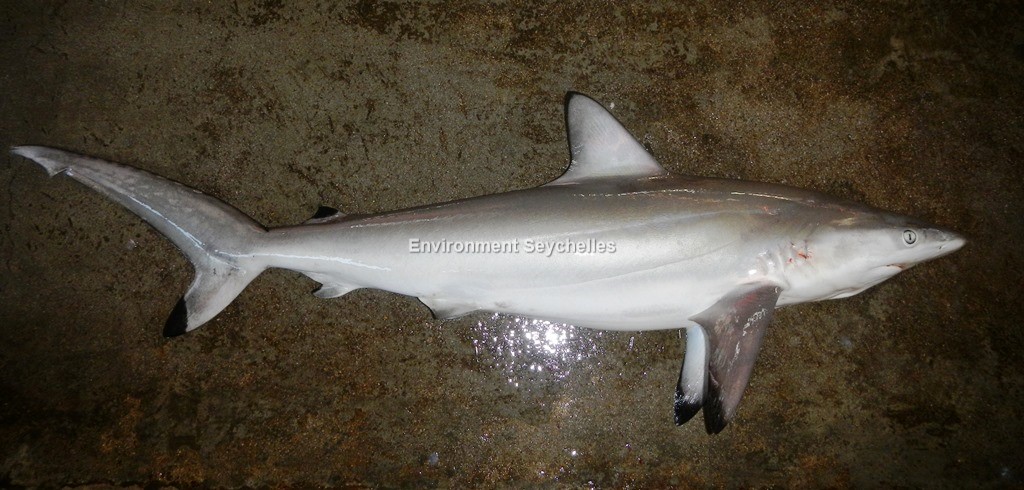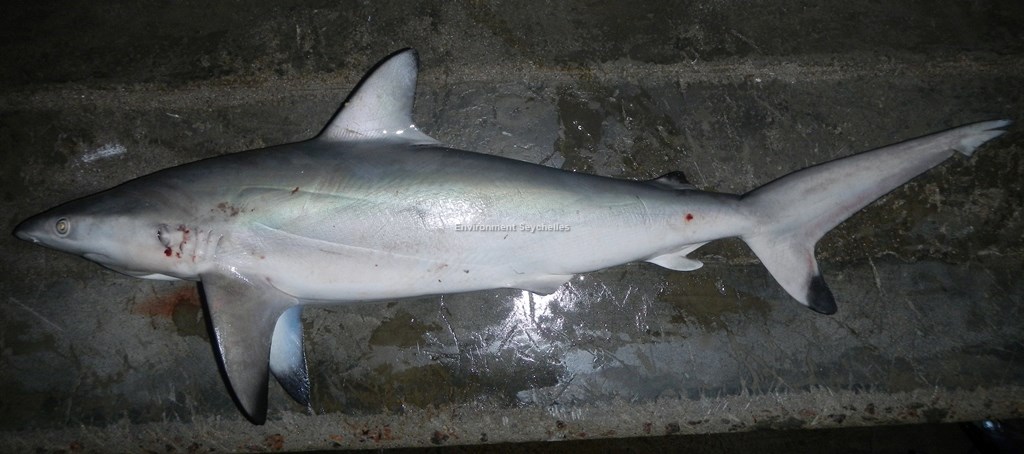Description:
Small sized, spindle-shaped shark with long rounded to sharply rounded snout. Grey to dark grey dorsally to pale or white ventrally often with conspicuous white band on flank.
Prominent black tip on ventral caudal lobe, pectorals and D2. D1 plain or black edged.
Fins: D1 medium-sized falcate, pointed or narrowly rounded apex with a short rear tip. Plain or a black edge to thin dark tip to apex. Origin typically posterior to pectoral
free rear tips (occasional specimens have origin slightly anterior). D2 small and low with black tip and long free rear tip (the terminal point of this tip is sometimes black).
Origin posterior to that of anal fin. Interdorsal ridge present – narrow and low. Pectorals small, falcate with narrowly rounded or pointed apices showing prominent black tips.
Pelvic and anal fins regular and plain (Note some specimens exhibit a dark to black edge to the posterior margin of the anal fin). Caudal ventral lobe has large prominent black
patch on lower portions and tip. Dorsal lobe with black edging.
Head: Long rounded to sharply rounded snout, large circular eyes, short gill slits. Anterior nasal flaps narrow and elongated to distinctive nipple-shaped lobes. Labial
furrows short and inconspicuous.
Size:
Born 45-60cm TL. Mature: Male approx. 105cm TL, Female 110-120cm, Maximum 160cm TL.
Habitat and Ecology:
Inhabits coastal waters and associated shelves (depth 0-140m). Occurs throughout the water column but mainly in midwater or near the surface. Feeds on teleosts and cephalopods.
Viviparous with 1-8 pups per litter after 10 month gestation period. Pupping starts in late December and continues through January in Seychelles. Young utilise coastal
shallow water nurseries, segregated from adults.
Fishery Status:
This species is not protected. It is however illegal to fish for sharks with nets (Fisheries Act, Reg 16.c). It is subject to hook and line, short anchored long line and
illegal net fishing. A relatively common species in the Seychelles artisanal fishery catch, mature adults however are rarely caught, suggesting that adults perhaps frequent
waters much further offshore than most of the literature indicates.
Notes:
References:
Ebert, D.A. et al (2013). Sharks of the World – A fully illustrated guide. Wild Nature press ISBN 978-0-9573946-0-5
Fisheries Act (2014). Prohibition of net fishing of sharks, Reg. 16c of 1st August 1998. (Carried over from the 1986 Fisheries Act as per Fisheries Act 2014 para 79:
Savings and Transitional provisions).
Froese, R. and D. Pauly. Eds. (2018). FishBase. https://www.fishbase.in/summary/Carcharhinus-sorrah.html (27/05/19).
Nevill, J.E.G. et al (2015). An identification guide for the sharks of the Seychelles Artisanal Fishery.
Pillans, R. et al (2009). Carcharhinus sorrah. The IUCN Red List 2009: e.T161376A5409506. http://dx.doi.org/10.2305/IUCN.UK.2009-2.RLTS.T161376A5409506.en. (27/05/19).
Simpfendorfer, C. et al (2021). Carcharhinus sorrah. The IUCN Red List 2021: e.T161376A173434793. https://dx.doi.org/10.2305/IUCN.UK.2021-2.RLTS.T161376A173434793.en. (08/10/21).
Citation:
Nevill, J.E.G. (2019). Carcharhinus sorrah, Spottail shark. Seychelles Seatizens. www.seatizens.sc. https://seatizens.sc/species/carcharhinus-sorrah-muller-henle-1839/ (Updated 08/10/21).




Great mix of humor and insight! For additional info, click here: READ MORE. Any thoughts?
buy generic lasuna – cheap himcolin for sale himcolin online order
buy generic besifloxacin online – purchase besifloxacin without prescription cheap sildamax without prescription
buy gabapentin tablets – azulfidine over the counter sulfasalazine pills
probalan where to buy – probenecid 500 mg price buy carbamazepine for sale
mebeverine 135mg canada – buy cilostazol 100mg generic pletal order online
order celebrex 100mg online cheap – celebrex 200mg ca indomethacin us
purchase diclofenac – voltaren 100mg pills buy aspirin 75 mg pill
buy generic rumalaya over the counter – cheap shallaki pills order amitriptyline 10mg pill
buy pyridostigmine for sale – sumatriptan 50mg cost azathioprine online order
buy diclofenac no prescription – cheap voveran sale nimodipine generic
baclofen cheap – order lioresal feldene without prescription
mobic 7.5mg for sale – order toradol without prescription oral ketorolac
buy trihexyphenidyl without prescription – cheap generic trihexyphenidyl diclofenac gel online purchase
buy cefdinir 300mg online cheap – oral omnicef buy cleocin generic
absorica order online – buy accutane 20mg without prescription buy deltasone 20mg for sale
order prednisone 10mg for sale – buy prednisolone 10mg generic where to buy zovirax without a prescription
cheap acticin – order generic tretinoin tretinoin for sale online
Please let me know if you’re looking for a writer for your site. You have some really great posts and I feel I would be a good asset. If you ever want to take some of the load off, I’d love to write some material for your blog in exchange for a link back to mine. Please blast me an e-mail if interested. Regards!
betnovate 20gm ca – purchase adapalene online purchase monobenzone online cheap
flagyl brand – purchase cenforce online cheap order cenforce 100mg without prescription
order augmentin 625mg pills – levothroid generic buy levoxyl pills
buy cleocin 300mg for sale – buy indocin generic indocin order
cozaar canada – order generic losartan 50mg buy cephalexin pills
eurax sale – purchase eurax sale buy aczone pills
semaglutide http://rybelsus.tech/# rybelsus price
Semaglutide pharmacy price